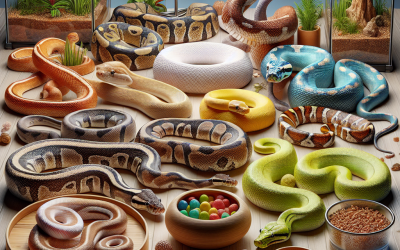Ball Python Care Guide: Everything You Need to Know
Introduction
Did you know that ball pythons are among the most popular snakes in the pet trade due to their docile nature and striking appearance? If you’re considering adding one of these fascinating reptiles to your family or are already a proud owner, understanding the essentials of their care is crucial. Welcome to the ball python care guide, a comprehensive resource designed to help you navigate the world of ball python ownership.
Ball pythons, known for their beautiful colorations and manageable size, are often recommended for both first-time snake owners and seasoned herpetologists alike. Their relatively easy care requirements make them a favorite. However, providing proper care involves more than just feeding and housing. You’ll need to consider habitat setup, dietary needs, health care, and appropriate handling techniques.
In this article, we’ll delve into everything you need to know about ball python care, from their habitat requirements to feeding and health care. By the end of this guide, you’ll be equipped with the knowledge to provide the best possible environment for your ball python. Learn about ball python habitats here.
What is the Ball Python Care Guide?
Definition
The ball python care guide serves as a blueprint for the optimal care and management of ball pythons. This guide encompasses all aspects of their husbandry, ensuring that owners understand the specific needs and behaviors of these reptiles.
Historical Context
Historically, ball pythons, or Python regius, were primarily found in the grasslands and forests of West and Central Africa. Over time, they have been bred in captivity, resulting in various morphs and color patterns that have increased their popularity as pets. Understanding this context helps owners appreciate the natural behaviors and needs of their ball pythons.
The Importance of the Ball Python Care Guide
As pet ownership trends evolve, more individuals are opting for reptiles like ball pythons. Proper care is essential not only for the health of the animal but also for the enrichment and enjoyment of the owner. Neglecting proper care can lead to health issues and behavioral problems in these snakes, making a solid understanding of their requirements crucial.
Ball Python Care Guide in the Context of Reptile Husbandry
In the broader scope of reptile husbandry, the ball python care guide sets a standard for best practices. It contributes to a growing body of knowledge that emphasizes the importance of replicating a natural environment, proper feeding, and health monitoring.
Key Players or Contributors
Numerous organizations and experts contribute to the knowledge surrounding ball python care. Groups like the Reptile Breeders and Keepers Association and various herpetological societies provide resources, research, and community support, all of which are vital for new and experienced owners alike.
Discover the best feeding practices for your ball python.

How Does the Ball Python Care Guide Work?
Purpose
The ball python care guide is designed to provide practical advice for owners, covering everything from habitat setup to feeding schedules and health checks. Understanding these components is key to ensuring your ball python thrives in its environment.
The Mechanics of the Ball Python Care Guide
- Habitat Setup: Creating a suitable living space for your ball python is essential. This includes:
- Enclosure Size: A 20-gallon tank is suitable for hatchlings, while adults require at least a 40-gallon tank.
- Substrate: Choose safe substrates like aspen bedding, coconut fiber, or paper towels.
- Temperature and Humidity: Maintain a temperature gradient of 75-80°F on the cool side and 90-95°F on the warm side, with humidity levels between 40-60%.
- Feeding Schedules: Ball pythons are typically fed every 5-7 days. Provide appropriately sized prey, such as:
- Fuzzy mice for hatchlings
- Adult mice or small rats for larger snakes
- Health Checks: Regular health assessments are vital. Watch for signs of stress, such as:
- Lack of appetite
- Excessive hiding
- Abnormal shedding
Technological Foundations of the Ball Python Care Guide
Advancements in technology have made it easier to care for reptiles. Tools such as thermostats and hygrometers help monitor temperature and humidity levels, while digital scales ensure accurate feeding measurements. Utilizing these tools can significantly enhance the quality of care you provide.
Benefits of Following the Ball Python Care Guide
Enhanced Health and Longevity
Adhering to the ball python care guide can lead to a longer, healthier life for your pet. Proper habitat conditions, feeding, and health monitoring all contribute to minimizing stress and preventing diseases.
Improved Owner-Pet Bonding
When owners understand their snakes’ behaviors and needs, it fosters a better relationship. Regular handling and proper care practices can help your ball python become more comfortable around you, making the experience rewarding for both parties.
Educational Experience
Caring for a ball python encourages continual learning. Each aspect of their care—from understanding their dietary needs to recognizing health issues—provides valuable insights into reptile biology and husbandry.
Explore how to keep your exotic pet mentally stimulated.
Common Challenges in Ball Python Care
Stress and Behavioral Issues
Ball pythons can experience stress due to improper handling, inadequate habitat conditions, or environmental changes. Signs of stress include:
- Hiding excessively
- Refusing food
- Aggressive behavior
Health Problems
Common health issues include respiratory infections, mites, and digestive problems. Regular veterinary check-ups and maintaining a clean habitat can prevent many of these issues.
Maintenance and Cleaning
Cleaning the enclosure regularly is vital for preventing bacteria buildup and ensuring a healthy environment. Spot clean daily and conduct a deep clean every 2-4 weeks.
Future Trends in Ball Python Care
Increasing Popularity of Morphs
As ball pythons continue to gain popularity, breeders are developing new morphs, expanding the variety of colors and patterns available. This trend will likely lead to an increased interest in specialized care practices tailored to different morphs.
Advancements in Reptile Care Products
The market for reptile care products is evolving. Innovations in habitat technology, such as automated thermostats and humidity controls, will make it easier for owners to maintain ideal conditions.
Community Support and Resources
Online communities and forums are becoming essential resources for ball python owners. These platforms allow for the sharing of experiences, tips, and advice, fostering a sense of community among reptile enthusiasts.
Join discussions on small mammals in our forums.
Conclusion
In conclusion, the ball python care guide is an invaluable resource for both new and experienced owners. Understanding the needs of your ball python—from habitat setup to feeding and health checks—can lead to a rewarding pet ownership experience. By following the best practices outlined in this guide, you can ensure your ball python thrives in a safe and enriching environment.
Whether you’re drawn to their unique appearance or their calm demeanor, providing the right care is crucial for your ball python’s health and happiness. Embrace the journey of ball python ownership, and remember that knowledge is key to building a strong bond with your new reptilian friend.
For more detailed insights into caring for your exotic pets, be sure to explore our other guides and resources. Happy herping!
Resource Links:
- reptifiles.com: Ball pythons (also known as royal pythons) are a terrestrial species of constricting snake native to regions of western and central Africa.
- reddit.com: … Personally, I also recommend bioactive enclosures, though that may be expensive for three ball pythons. The sub also has a guide for that if you …
- community.morphmarket.com: … Our minimum recommended size for an adult ball python is a 36” x 18” x 12” enclosure, but we personally prefer a 4′ x 2′ x 1′.




0 Comments